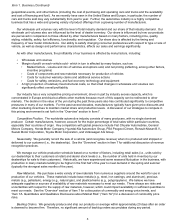Ford 2014 Annual Report Download - page 18
Download and view the complete annual report
Please find page 18 of the 2014 Ford annual report below. You can navigate through the pages in the report by either clicking on the pages listed below, or by using the keyword search tool below to find specific information within the annual report.Item 1. Business (Continued)
Some European countries have implemented or are considering other initiatives for reducing CO2 vehicle emissions,
including fiscal measures and CO2 labeling. For example, the United Kingdom, France, Germany, Spain, Portugal, and
the Netherlands, among others, have introduced taxation based on CO2 emissions. The EU CO2 requirements are likely
to trigger further measures. To limit GHG emissions, the EU directive on mobile air conditioning currently requires the
replacement of the current refrigerant with a lower “global warming potential” refrigerant for new vehicle types, and for all
newly registered vehicles starting in January 2017. A refrigerant change adds considerable costs along the whole value
chain.
Other National Requirements. The Canadian federal government has regulated vehicle GHG emissions under the
Canadian Environmental Protection Act, beginning with the 2011 model year. The standards track the new U.S. CAFE
standards for the 2011 model year and U.S. EPA GHG regulations for the 2012-2016 model years. In October, 2014, the
Canadian federal government published the final changes to the regulation for light duty vehicles, which maintain
alignment with U.S. EPA vehicle GHG standards for the 2017-2025 model years. The final regulation for 2014-2018
heavy duty vehicles was published in February 2013.
Mexico adopted fuel economy/CO2 standards, based on the U.S. One National Program framework, that took effect in
2014.
Many Asia Pacific countries (such as Australia, China, Japan, India, South Korea, Taiwan, and Vietnam) are
developing or enforcing fuel efficiency or labeling targets. For example, South Korea and Japan have set fuel
efficiency targets for 2020, with incentives for early adoption. China published standards for Stage IV fuel efficiency
targets for 2016–2020. The fuel efficiency targets will impact the cost of vehicle technology in the future.
In South America, Brazil introduced a voluntary vehicle energy-efficiency labeling program, indicating fuel
consumption rates for light duty vehicles with a spark ignition engine. Brazil also published a new automotive regime
which requires participation in the fuel economy labeling program. It establishes a minimum absolute CAFE value as
a function of Fleet Corporate Average Mass for 2017 light duty vehicles with a spark ignition engine in order to qualify
for industrialized products tax reduction for customers. Additional tax reductions are available if further fuel efficiency
improvements are achieved. A severe penalty system will apply to qualified manufacturers failing to meet fuel
efficiency requirement for the 2013–2017 sales period. Chile introduced requirements for fuel consumption and CO2
emissions levels of light duty vehicles to be posted at sales locations and in owner manuals beginning in February
2013. Chile introduced a tax based on urban fuel consumption and NOx emission for light and medium vehicles
beginning in late 2014. In general, fuel efficiency targets may impact the cost of technology of our models in the
future.
Vehicle Safety
U.S. Requirements. The National Traffic and Motor Vehicle Safety Act of 1966 (the “Safety Act”) regulates vehicles
and vehicle equipment in two primary ways. First, the Safety Act prohibits the sale in the United States of any new vehicle
or equipment that does not conform to applicable vehicle safety standards established by NHTSA. Meeting or exceeding
many safety standards is costly, in part because the standards tend to conflict with the need to reduce vehicle weight in
order to meet emissions and fuel economy standards. Second, the Safety Act requires that defects related to motor
vehicle safety be remedied through safety recall campaigns. A manufacturer is obligated to recall vehicles if it determines
the vehicles do not comply with a safety standard. Should we or NHTSA determine that either a safety defect or
noncompliance exists with respect to any of our vehicles, the cost of such recall campaigns could be substantial.
12
























